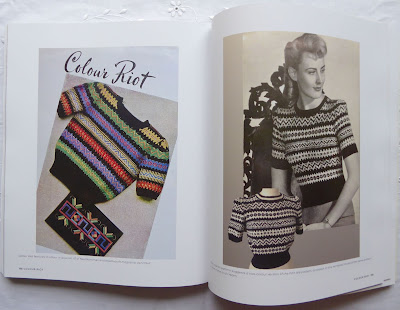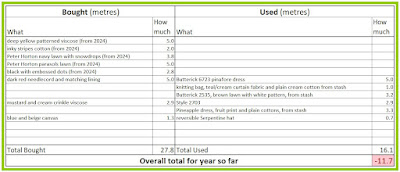Having, finally,
decided on a design for my pineapple dress I went to cut it out - and made a discovery about the fabric.
 |
| It naturally curled when folded over |
The selvedge was very tightly woven, to the extent that it actually puckered. Fortunately, just snipping the selvedge at fairly close intervals fixed the problem and caused it to lay flat.
I wanted to match the pattern on the skirt centre back seam, as I felt that such a bold design would look terrible if it didn't align. I cut one piece, and traced round various fruits and flowers in the seam allowance.
 |
| The tracing is just visible here |
Then I flipped the pattern over, and used these tracings to place it correctly on the fabric for the other piece. I'm pretty pleased with the way it worked out.
 |
| Good match! |
The bodice back slopes down the centre seam, so pattern matching isn't possible. Instead, I cut the pieces out so that pattern flows across it. Similarly I made sure that obvious elements such as the pineapples and oranges are at the same height round the skirt. I took particular care placing the bodice front pattern piece - I didn't want a pair of pineapples in 'interesting' positions!
It dawned on me that in all the examples I had seen, the contrast element of the bodice has a top edge which is pretty much straight across, whereas mine curves up at the outer edges. I experimented with a mock-up, and decided that I preferred my version. Such are the advantages of making your own clothes! I completely forgot to take any progress shots, but it was built up on an interfaced inner layer. The two pieces for the outer layer were sewn in place along the top edge, then the excess fabric was pleated and stitched down. Finally the inner and outer layers were overlocked together along the lower outside edge. The insert is just hand sewn in place, and I am considering making at least one more in a different fabric.
 |
| The completed bodice |
The skirt is quite full, and there's a lot to hem. Fortunately I remembered that on a day trip to a meeting in London last autumn I had found time to pop into
MacCulloch and Wallis (because of course I did!) and bought, among other things, these.
 |
| I had wanted these for ages |
The bottom item is a kakehari or 'third hand'. The clamp is screwed onto something solid, such as a table, the
kakehari is attached to this, and then it holds the fabric in place so you can tension it with one hand and sew with the other.
 |
| In action, albeit the wrong way round for most people |
Because I am left-handed, I sewed with my left hand and held the fabric taut with my right. It made the job much easier, and quicker.
And here is the finished dress, complete with matching belt.
 |
| The 'fruits' of my labour (sorry not sorry) |
 |
| #sewnshownseated |
Naturally, a dress with large pineapples on it need to be accessorised with a pair of pineapple earrings! These are from a shop called Digger, in Edinburgh. It first opened when I used to live up there, forty-plus years ago, and I always pop in when I'm back. I was delighted to spot the earrings on one trip, as I knew that they would be perfect with this dress - if I ever made it!
 |
| Digger has always looked like this |
The stashometer meanwhile remains in the red, but slightly less than before.
 |
| Better, but still not good |
I need to get sewing with some of those fabrics on the left column if I'm going to get anywhere close to stash-neutral.



























